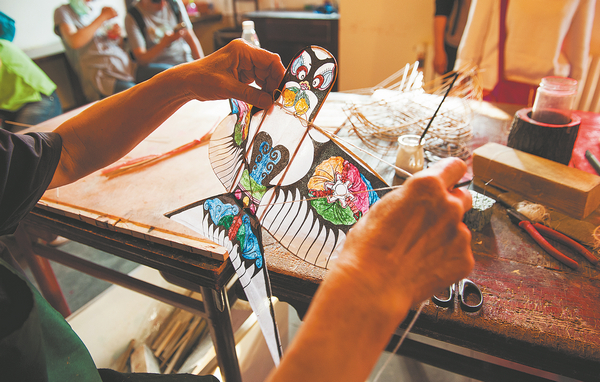Modern travelers immerse themselves in traditional life
Intangible cultural heritage provides rich experiences.
Yao Bin and his two children spent a long time studying a large brick-carved artwork during their visit to a theme park in Shunde, Guangdong province, late last month.
The work, which is 8.5 meters high and 3 meters wide, features Cantonese opera performers and martial arts practitioners in the foreground, while the rest of the space is taken up with distinctive local architecture and natural scenery.
Yao said, "Its sheer size is impressive, and you can see the delicate details at close quarters."

The work was meticulously created by He Shiliang, an inheritor of brick-carved artwork, which was named a provincial intangible cultural heritage in 2007.
The work meets the standards of even the most discerning critic, with its clear-cut strands of hair on the characters, layered folds of their clothing, shimmering ripples on the surface of a river, and intricate patterns on the stems of flowers and plants.
The Yao family, from Fujian province, was not satisfied with just posing for photographs in front of this work, but took time to fully appreciate it.
"I noticed its cultural significance when I was making my travel plans, such as the way in which this creation reflects regional characteristics and is a delicate work of art on its own merits," Yao said.
He made a point of taking his children to appreciate the work during a visit to the OCT Harbour Plus theme park.
Creating the work involved sculpting figures or patterns on high-quality, fine-textured green bricks. Its distinctive characteristics include delicate knife work, smooth and free-flowing lines, fine and detailed craftsmanship, well-defined layers, a strong 3D visual impact, and lifelike representations.
Whether viewed from a distance or close up, the work is aesthetically pleasing and captivating.
It took He two years to complete, and the work — part of the theme park's efforts to integrate tourism and intangible cultural heritage — has attracted numerous visitors to the venue since being unveiled in April 2020.
"Although this is not my largest work, it is the most special," He said.
He added that he was excited about the theme park's idea in 2018 to integrate tourism and local culture, so he ensured that the work included as many traditional cultural elements from Shunde as possible.
"It can help visitors experience something authentic and special about Shunde," He said.

Other forms of local intangible cultural heritage, such as dragon boat races, have been highlighted at the park during public holidays.
Chen Zhenqiu, who was named a national inheritor of dragon boat singing in 2018, has been invited to perform at the park in recent years.
"It's been a delight to perform dragon boat singing in front of so many visitors from across the country and have such large audiences hear this traditional artform," Chen said.
"Performances at tourist attractions and interaction with visitors are beneficial in bringing intangible cultural heritage to life and increasing its popularity."
Wang Jihai, a senior staff member at the theme park, said such experiences, which have proved popular with visitors, are aimed at enabling them to experience local history and culture.
Intangible cultural experiences have been beneficial for the park's operations nationwide.
Such events at OCT Fabland Xiangyang in Hubei province have drawn about 1 million visitors annually since the venue opened in 2020.
Learning tours at the Xiangyang attraction that highlight local intangible cultural heritage attracted a total of more than 50,000 visits from primary and middle school students by the end of last year.
Wang Xiaofeng, president of the China Intangible Cultural Heritage Protection Association, said that as a key tourism resource, intangible cultural heritage is one of the most dynamic ways to integrate culture and tourism.
Such heritage signals the achievements of the nation's culture and history, reflects cultural diversity, and provides a way to meld culture and tourism, Wang said.
More than 80 percent of China's intangible cultural heritage is named after the regions or ethnic groups from which it derives, and it provides tourists with a wealth of local customs, craftsmanship and performing arts, Wang said.
The strong local flavor of this heritage can add to the appeal of travelers' cultural exploration trips, he added.
A growing number of examples of intangible cultural heritage and their inheritors are featured at tourism areas to enrich visitors' experience.


